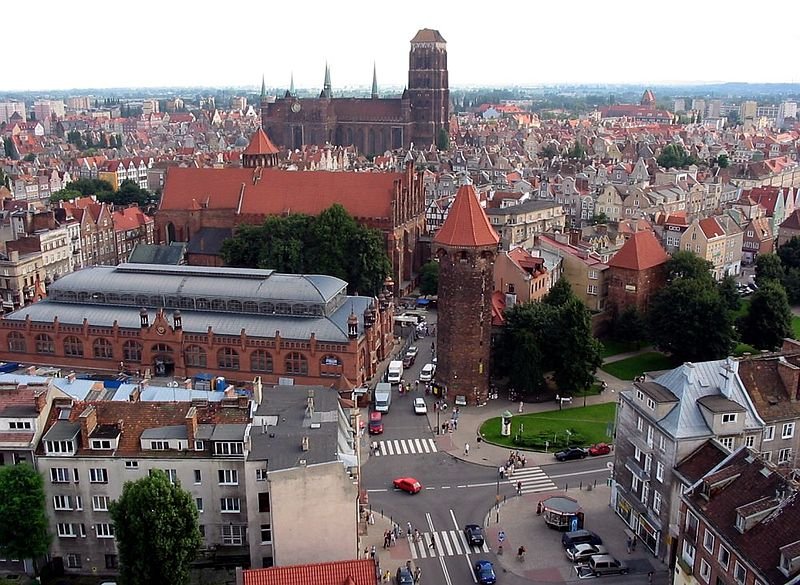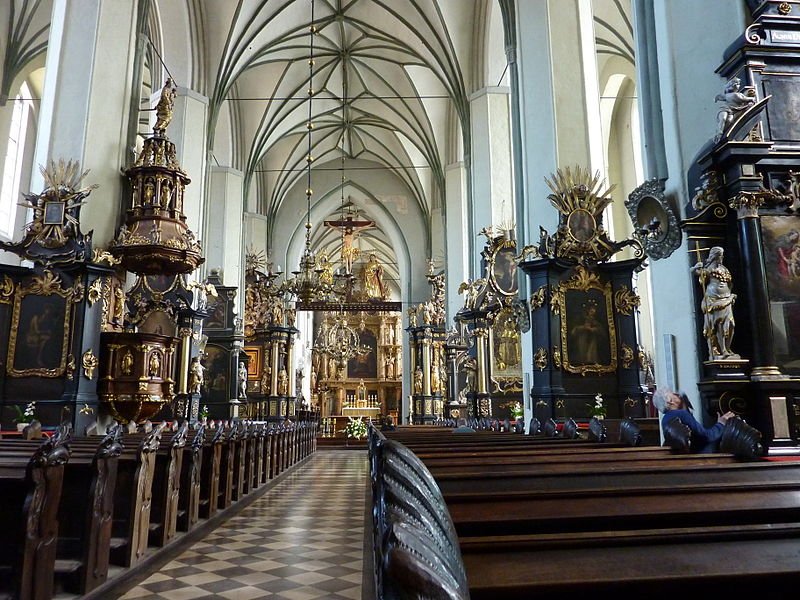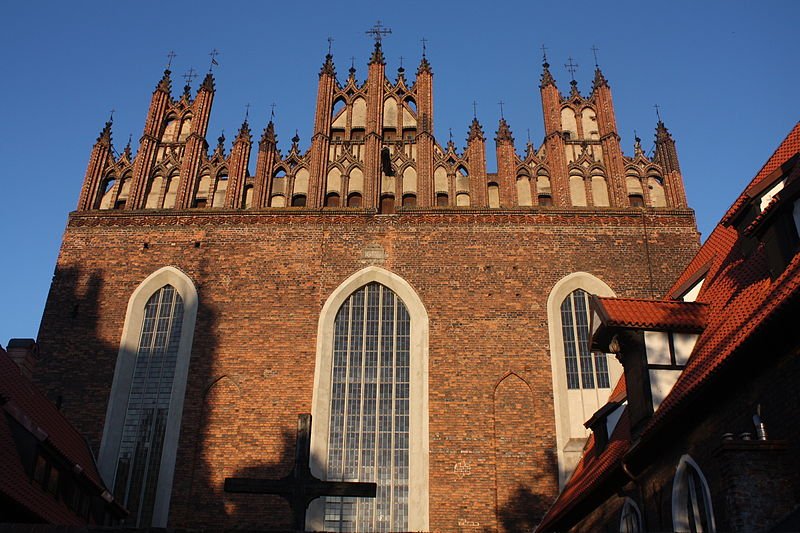 Gdańsk, Poland
Gdańsk, PolandSource: https://commons.wikimedia.org/wiki/File:Gdansk_2004.jpg
Author: Tomasz Sienicki

Gdańsk (German: Danzig) is a beautiful city on the northern part of Poland. Covering 262 sq km (101.2 sq mi), the city faces the Gdańsk Bay which opens into the Baltic Sea. Gdańsk has population of 456,000 (2011 estimate) which a metropolitan area of over a million people. It is the sixth largest city within the fourth largest metropolitan area in Poland.
 The Żuraw of Gdańsk
The Żuraw of GdańskSource: https://commons.wikimedia.org/wiki/File:Puerta_%C5%BBuraw,_Gdansk,_Polonia,_2013-05-20,_DD_02.jpg
Author: Diego Delso

More on Gdańsk
Gdańsk is the main seaport for Poland. Its location at the mouth of the Motława River places it on the waterway connected to Warsaw. This enables some supplies for much of Poland to pass through it. The city also has a thriving economy based on shipbuilding. Other major industries include petrochemical, chemical and food processing.Gdańsk experiences a temperate climate. The warmest month is July, when the average high temperature rises to 20.4°C (68.7°F). July is also the wettest month, receiving 79 mm (3.11 in) of precipitation. Coldest month is January, when the average low temperature drops to -3.5°C (25.7°F).
 Neptune Monument, Gdańsk
Neptune Monument, GdańskSource: https://commons.wikimedia.org/wiki/File:FONTANNA_NEPTUN426.jpg
Author: Cybolski

Gdańsk has a long history going back to AD 997. It was the capital of a Slav duchy in Pomerania until 1308, when it was taken over by the Teutonic Knights, who ushered in an era of growth for the city. In 1361 Gdańsk became a member of the Hanseatic League, which further boosted its economic growth.
Gdańsk was part of Poland from 1466 until 1733, when it was captured by Russia. From then on the city went into decline as it suffered the brunt of wars. Then in 1793 it was taken by the Kingdom of Prussia. It became a free city during the era of Napoleon Bonaparte until the defeat of Napoleon, when it again came under Prussian rule.
 Church of St Nicholas (Wnętrze bazyliki św. Mikołaja), Gdańsk
Church of St Nicholas (Wnętrze bazyliki św. Mikołaja), GdańskSource: https://commons.wikimedia.org/wiki/File:Gdansk-Bazylika-sw-Mikolaja-1.jpg
Author: Stanislaw Kosiedowski

When Poland fell under the Nazis during the Second World War, Gdańsk was annexed and made part of Reichsgau Danzig-West Prussia. Under Nazi occupation, many of the Jews in Gdańsk were systematically liquidated.
Gdańsk remained under German rule until the end of World War I, when Polan regained its independence. The city suffered severe devastation in the war, but was rebuilt in the post-war period, with many of its historic buildings restored. Gdańsk is best remembered as the birthplace of the Solidarity movement which played a significant role in bringing an end to communism in Europe.
 Oliwa Cathedral, Gdańsk
Oliwa Cathedral, GdańskSource: https://commons.wikimedia.org/wiki/File:Archikatedra_Oliwska_01.JPG
Author: Wisniowy

Visiting Gdańsk
The Gdańsk Lech Wałęsa Airport (GDN) is the gateway to Gdańsk. It receives regular flights from major cities in Europe. Arriving at the airport, you have the option of taking the public bus, the Airport shuttle bus, the taxi or private pick-up. Bus 210 travels between the airport and downtown Gdańsk. The fare is 3 PLN if ticket is bought through a news stand. The airport shuttle bus takes you directly to the city center and costs 9.90 PLN. Taxi fare is around 50-60 PLN. Church of the Holy Trinity (Kościół Świętej Trójcy), Gdańsk
Church of the Holy Trinity (Kościół Świętej Trójcy), GdańskSource: https://commons.wikimedia.org/wiki/File:Gdansk_Kosciol_Franciszkanow_007.jpg
Author: Ludwig Schneider

Sights & Attractions in Gdańsk
- Arsenal
Built in the early 17th century, this is one of the finest buildings of the Mannerist style in Gdańsk. - Artus Court
The watering hole for the wealthy burghers of Gdańsk, this is an example of the fratenity that was particularly popular during the time of the Hanseatic League. - Central Maritime Museum
Museum dedicated to documenting the maritime history of Poland, particularly during the 17th century, when it was striving to be the master of the Baltic Sea. - Długi Targ and Długa
Together, these are the loveliest streets in Gdańsk passing through some of the most handsome houses in the city. - Gdańsk National Museum
Housed in the former Gothic Franciscan monastery, the museum houses a treasure trove of artifacts from Polish history. - Golden Gate
City gate built in 1612-14 on the site of the Ulica Długa Gate. - Golden House
A beautiful house from the early 17th century built by Jan Speimann, the mayor of Gdańsk. - Green Gate
City gate that looks more like a mansion than a gate. It was built this way to double as a residence for any visiting royals. - Highland Gate
Gateway at the start of the Royal Way that was prt of the city fortifications built by Hans Kramer of Saxony. - Kaplica Królewska
The Royal Chapel was built for Roman Catholics to use after the parish of St Mary became a Protestant church in 1529. - Kościół Mariacki
The Church of St Mary, which was started in 1343 and completed some 150 years later, is the biggest medieval brick church in Europe. Destroyed during the Second World War, it was rebuilt according to its original design. - Kościół św Brygidy
The Church of St Bridget, dating to 1514, was where members of the Solidarity movement came to worship. - Kościół św Katarzyny
The Church of St Catherine is the oldest and most important parish church is the Old Town of Gdańsk. - Kościół św Trójcy
The Church of the Holy Trinity was built by Franciscan monks in the 15th century. When worshippers declined due to conversion to Protestantism, the monks handed the monastery to the city to be a theological college, and the church was passed to the Protestants. - Main Town Hall of Gdańsk
Town hall building that dates to 1327, with rebuilding and remodelling in the subsequent centuries. - Monument to the Fallen Shipyard Workers of 1970
Monument built following the Gdańsk Shipyard Workers' strike of 1980, to honor those killed in the strike and demonstrations of 1970. - Old Town Hall
The 16th century town hall building designed by Antonis van Opbergen is an outstanding example of Dutch Mannerist architecture. - Oliwa Cathedral
Cathedral and monastery originally built by wealthy Cistercians in the Gothic style. - Polish Post Office Museum
Museum commemorating the heroism of the postal workers who were attacked by German troops at the start of the Second World War. - Prisoner Tower
Originally built as part of a city gate, the tower is today a mix of architectural styles, due to successive rebuildings. In the 16th century it was used as a prison and torture chamber. - Raduna Canal
Canal dug by the Teutonic Knights for Gdańsk in 1338. many important historic buildings are today on its path. - Spichlerze Island
Island created as a result of the New Motłowa Canal, dug in 1576. - St George's Court
Building belonging to the medieval fraternity of St George, an association of archers, was built in the Flemish style in 1494. - Ulica Długa
Literally the "Long Street", this is the main street through the Old Town of Gdańsk. - Ulica Mariacka
One of the loveliest street in Gdańsk, Ulica Mariacka is lined with outstanding examples of traditional Polish architecture. - Uphagen House
18th century residence of Johann Uphagen, a town councillor, exhibiting a fusion of Baroque, Rococo and early Neo-Classical features. - Westerplatte
Westerplatte is the garrison where the Germans fired the first shots of World War II. Today a monument is erected to commemorate the defenders' heroism. - Wielki Młyn
The Great Mill in Gdańsk is one of the biggest industrial buildings of medieval Europe. It was built by the Teutonic Knights around 1350. - Wisłoujście Fortress
Fortification at the mouth of the River Vistula first built under the Teutonic Knights in 1482. - Żuraw
The Gdańsk Crane built in the 14th century is a unique medieval structure that has become the icon of the city.
 Latest updates on Penang Travel Tips
Latest updates on Penang Travel Tips

Copyright © 2003-2025 Timothy Tye. All Rights Reserved.

 Go Back
Go Back